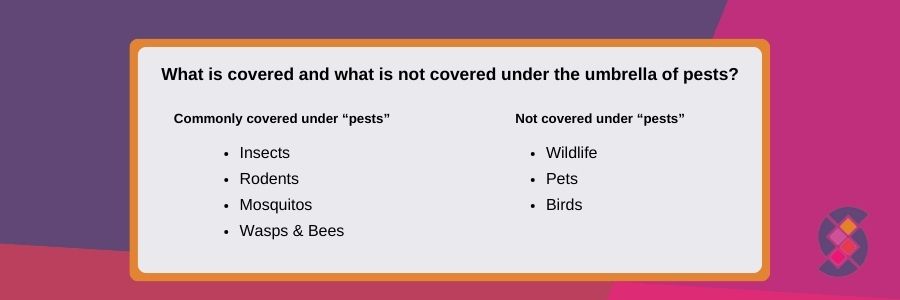Is Body Corporate Responsible for Pest Control in Strata Buildings?
When it comes to shared residential and commercial properties, the body corporate is responsible for maintaining the common property for the benefit of the unit holders.
In strata managed properties, one of the most crucial aspects to ensure the health and safety of tenants is pest control. But just like many things in strata managed buildings, residents are sometimes left scratching their heads when it comes to knowing what is classified as a personal responsibility versus a shared responsibility covered under the umbrella of strata maintenance.
To provide some clarity on the matter, we’ll detail the difference between individual pest control and shared pest control in strata managed buildings.
Who is responsible for pest control in strata managed buildings?
First off, it’s important to understand that strata managed buildings in each state and territory in Australia are governed by a separate, state-level set of laws.

New South Wales: Strata Schemes Management Act 2015
Victoria: Owners Corporation Act 2006
Queensland: Body Corporate and Community Management Act 1997
Western Australia: Strata Titles Act 1985
South Australia: Strata Titles Act 1988
Tasmania: Strata Titles Act 1998
Australian Capital Territory: Unit Titles (Management) Act 2011
Northern Territory: Unit Titles (Management) Act1975

While each of these documents outlines the nuances pertaining to different locations around Australia, they all separate the responsibility of pest control into shared and collective responsibility.
Responsibility of the body corporate
Pest control expenses in strata managed buildings are typically shared between all owners in a strata scheme. Shared pest control covers all common spaces, entry points, shared facilities, gardens, and other areas of a property that are reasonably deemed to be a shared space. In these shared areas of a strata managed building, it is the responsibility of the body corporate to ensure that they remain free from pests.
Responsibility of individual lot owners
When it comes to individual units within a strata property, it is the responsibility of each owner or tenant to ensure that they remain free from pests. If pests become an issue in an individual property due to negligence or lack of cleanliness, it is the responsibility of the individual to organise pest control.
Just like repairs, if pests are deemed to have resulted from the neglect of an individual lot owner or tenant, then they may be responsible for arranging and bearing the financial responsibility of pest control.
What is covered and what is not covered under the umbrella of pests?
When it comes to pest control, it’s important to understand what is and what is not covered under the umbrella of “pests”. In general, here is a list of what is typically covered under the umbrella of “pests” and what might not be.
Commonly covered under “pests”
Insects: Cockroaches, fleas, spiders, termites, ants, and other insects that may become present through neglect or hygiene issues.
Rodents: Mice and rats are the most common types of rodents that Australians are faced with. Strata managed properties that become a hotspot for rats or mice can cause serious health and safety implications for tenants. Once rats or mice set up shop, it can be difficult to get rid of them and tenants may face issues with rodents infesting individual lots.
Mosquitos: In areas where there are large bodies of water or green areas, mosquitos can transform from a simple annoyance to a nuisance. It can sometimes be a grey area where to draw the line, so the matters are best discussed with your body corporate.
Wasps and bees: Again, wasps and bees are a natural occurrence and, in moderation, do not pose any real threat to tenants of strata managed buildings. However, when wasps or bees create nests, they can become a safety issue for tenants to remove or come into contact with.

Not covered under “pests”
Wildlife: Whilst not covered under the umbrella of pests, possums accessing roof spaces (that are deemed as common property) can cause damage to property and nuisance to residents. If possums are accessing common roof spaces, the body corporate can investigate to find the entry points in order to have them closed off. Possums can then be caught and released back into the environment.
Pets: As much as you might think the neighbours’ barking dog is a pest, pets are not covered under the umbrella of pest control. Individual pet owners are responsible for ensuring that their pets do not become a nuisance for neighbours by controlling noise and collecting waste in a timely manner.
Birds: Birds are not covered under the umbrella of pest control. If there are other issues that may be attracting birds to the property such as uncovered waste or residents feeding them, then it is the responsibility of the tenants and the body corporate to come up with a shared solution. Similar to possums, if birds are accessing and nesting in the common roof space the body corporate can investigate to find the entry points in order to have them closed off.
How often should pest control be carried out in strata buildings?
When it comes to how often pest control should be carried out, it comes down to the specific requirements of the building. Factors such as the age of the building, number of lots, size and quantity of shared spaces, as well as the location of the building will all determine how often pest control in strata managed buildings should be carried out. Regular communication between residents and the body corporate is the best way to determine an effective pest management plan that safeguards the best interests of owners and tenants.



